 |
||
|
Hubble
Space Telescope image of Titan, left, and Mimas, Tethys, Janus and Enceladus.
|
||
| THE MOONS OF SATURN | ||
| Saturn and Jupiter have the most extensive satellite families of the Solar System. Of Saturn's moons, all but one are between 20 kilometres and about 1000 kilometres in diameter. The smaller moons are overshadowed by the giant orange globe of Titan (5050 kilometres across). Titan was once thought to be the largest known satellite until it was shown that its atmosphere hides a solid body smaller than Jupiter's Ganymede. | ||
| Discovery | ||
| Not surprisingly, Titan was the first of Saturn's satellites to be discovered. Christaan Huygens, a Dutch scientist, found it in 1655. In 1671 Cassini discovered Iapetus, then Rhea in 1672, and then the fainter Dione and Tethys in 1684. It was just over a hundred years before any more of Saturn's moons were revealed. In 1789, the British astronomer William Herschel was able to report the discovery of two more satellites : Mimas and Enceladus. | ||
| Observations during the 1960s showed that during a ring-plane crossing (when Saturn's rings are seen edge-on from Earth) another moon normally hidden by the bright glare of the rings had been awaiting discovery. But it was not until the Voyager mission that the existence of Janus could be confirmed. Using Voyager images, several more small moons were found in the early 1980s. Prometheus and Pandora, shepherd moons, maintaining the F-ring. The Trojan moons Telesto and Calypso, located 60o ahead of Tethys, and Atlas and Epimetheus. There have been reports of other small moons about Saturn - three additional Tethys Trojans and two more moons (besides Helene) co-orbital with Dione. | ||
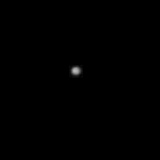 Telesto. |
||
| More about Telesto | ||
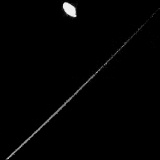 Calypso. |
||
| More about Calypso | ||
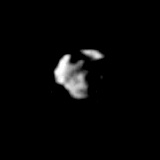 Helene. |
||
| More about Helene. | ||
| Orbits | ||
| Most of Saturn's regular satellites are located fairly close to the planet, the outermost of these being Rhea, just over 0.5 million kilometres away. Titan is 1.2 million kilometres from Saturn, and the other outer satellites, Hyperion, Iapetus and Phoebe are found at intervals of increasing distance from the planet. | ||
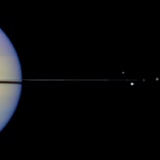 Hubble Space Telescope image of Mimas, Tethys, Janus and Enceladus, clustered at the western side of the edge-on ring system. |
||
| Phoebe has an orbit nearly 13 million kilometres from Saturn. Eleven of the thirteen moons discovered between 2000 and 2003 orbit beyond Phoebe at distances between 15 million kilometres and 23 million kilometres; like Phoebe they are irregular with inclined, eccentric, and retrograde orbits which mean that they orbit Saturn in the opposite direction to Saturn's own rotation and the paths of the inner moons. | ||
 Phoebe. |
||
| Phoebe, the other irregular satellites, and probably Hyperion with its red colouration and odd-shape, are quite likely captured asteroids or the result of collisions in more recent Solar System history. However, the other large moons at least have evolved as part of the Saturnian system. | ||
| More about Phoebe | ||
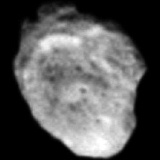 Hyperion. |
||
| Phoebe, and probably Hyperion with its red colouration and odd-shape, are quite likely captured asteroids or the result of collisions in more recent Solar System history. However, the other large moons at least have evolved as part of the Saturnian system. | ||
| More about Hyperion | ||
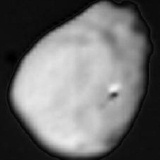 Janus. |
||
| Janus and Epimetheus are virtually co-orbital, but not quite. They orbit at 151,472 kilometres and 151,422 kilometres from Saturn and interact in a most remarkable way. When the satellite on the inner track approaches the outer satellite it gains orbital momentum increasing the radius of its orbit at the same time as slowing the outer satellite down. The outer satellite drops into a lower and faster orbit. | ||
| More about Janus | ||
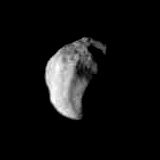 Epimetheus. |
||
| The satellite on the inner track at first is now the outermost. It is not known how this behaviour was established but it may have been initiated in the break up of a single larger body already orbiting Saturn. | ||
| More about Epimetheus | ||
 The orbits of Titan, Hyperion, Iapetus, and Phoebe. |
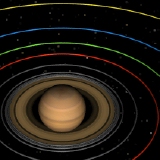 The orbits of Enceladus, Tethys, Telesto, Calypso, Dione, Helene, and Rhea. |
|
 The orbits of Pan, Atlas, and Prometheus. |
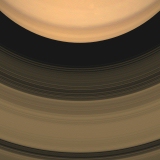 Map of Saturn's rings and moons. |
|
| Moons and rings | ||
| Some of the inner moons of Saturn are responsible for controlling the structure of Saturn's ring system. If a ring particle has an orbital period in resonance with a moon, then the additional gravitational force applied by the moon removes the particle from that orbit. In this way the moons create gaps in the rings. This is similar to the process that forms the Kirkwood Gaps in the asteroid belt. However, this method only explains some of the gaps in the rings. | ||
| Indeed, it was discovered that one of Saturn's rings exhibited gravitational perturbations, without an accompanying moon. A search of over 30,000 Voyager images lead to the discovery of Pan. | ||
| More about Saturn's ring system | ||
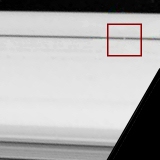 Pan. |
||
| More about Pan | ||
| Composition | ||
| Saturn's moons share many physical traits. The densities of some of the small moons are not yet established, but as far as we know, all Saturn's satellites have very low densities. Knowing the amount of mass per unit volume tells us something of their make-up. Titan, for example, which has the highest density of Saturn's moons (1880 kg m-3) is nearly twice as dense as water ice. This information is used in conjunction with other information about the body to infer that it is half rock, half water ice. The lack of a magnetic field indicates that there is no surviving liquid layer - once suggested as a result of the heat made available from the formation of such a large body. The ices which surround the core are probably layered forming a series of concentric shells. The deeper ices are so highly compacted that their molecular arrangement differs from normal ice. | ||
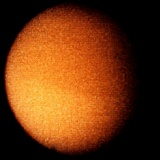 Saturn's largest moon, Titan. |
||
| More about Titan | ||
| The other satellites have even lower densities. Mimas, Iapetus, and Tethys all have densities of about 1000 kg m-3 . Since they contain so much water and so little rock, the interiors of these moons (and perhaps those of Dione and Rhea) probably lack a layered structure. It is possible though that Dione does have a small rocky core. Enceladus may have a thin crust and is internally differentiated because there are signs that it has been geologically active very recently. | ||
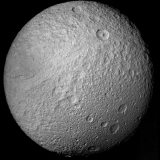 Tethys. |
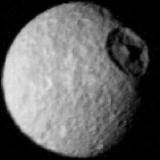 Mimas. |
|
| More about Tethys | ||
| More about Mimas | ||
 Iapetus. |
 Prometheus. |
|
| More about Iapetus | ||
| More about Prometheus | ||
| The smaller innermost satellites (Prometheus, Pandora, Epimetheus and Janus) have densities of 700 kg m-3, which is lower than water. This suggests that they are porous with lots of tiny empty spaces embedded in them. | ||
| Surfaces | ||
| With the exception of Hyperion, Iapetus, and Phoebe, which have albedos or reflectivity values of 0.3 or less, Saturn's moons are very bright. Even the small inner satellites are very reflective, particularly Pandora and Atlas. | ||
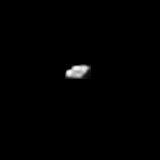 Atlas. |
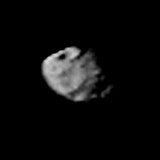 Pandora. |
|
| More about Atlas | ||
| More about Pandora | ||
| The brightest of Saturn's moons, however, is Enceladus. It is thought that a frosty coating of ice from recent volcanic eruptions is responsible for reflecting 99% of the light which reaches its surface. | ||
| Enceladus has many craters, but is nonetheless, the least densely cratered of the Saturnian satellites. It has grooved terrain similar to Jupiter's moon Ganymede and large regions which contain relatively few craters. These grooves, or "sulci" as they are known, may have formed through the eruption of liquid onto the surface. | ||
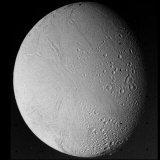 Enceladus. |
||
| More about Enceladus | ||
| Saturn's moons are heavily cratered. Rhea, Tethys, and Dione are the most heavily scarred by impacts. Mimas has a density of craters similar to that of the lunar highlands. Tethys and Mimas, both have extraordinarily large craters for their size, resulting from impacts which came close to breaking them apart. | ||
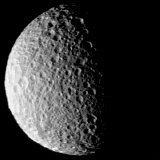 Rhea. |
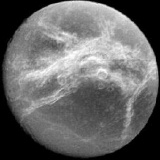 Dione. |
|
| More about Rhea | ||
| More about Dione | ||
| Most of the spherical moons have chasmata or canyons. These could have opened up as the surface cooled and expanded. This took place shortly after the formation of the body, as the heat from their accretion rapidly dissipated. | ||
| Exploration | ||
| Though the main target of the Cassini-Huygens mission in 2004 will be Titan, the Cassini orbiter will make flybys of other moons, in the same way as Galileo at Jupiter was able to make passes of Jupiter's Galilean moons. Better images and more complete coverage of many of them will result. The outermost satellites (Iapetus, Hyperion, and Phoebe) will, for the time being at least, remain enigmatic. | ||
| A successful mission will boost our understanding of how these ice bodies have evolved, it will help us to piece together their history and learn how modification by internal and external processes have changed their surfaces. We might discover what gives Dione and Rhea their wispy markings, how the weird grooved terrains were formed on Tethys and Enceladus, how Tethys and Mimas were able to survive such giant asteroid collisions, and learn more of Enceladus' volcanic past. | ||
| Saturn's other moons | ||
| In 2000, eleven previously unknown moons were discovered by astronomers using the 3.6 metre Canada France Hawaii Telescope on Mauna Kea and the 2.2 metre European Southern Observatory telescope in Chile. Several months of careful continued observations confirmed their orbits and established them as moons, ruling out the possibility that they were asteroids or comets in the Saturn vicinity. Another Saturn moon (S/2003 S1) was found in 2003 with the aid the 8.3 metre Subaru Telescope, also on Mauna Kea. | ||
| S/2003 S1 was discovered in a pair of digital images obtained 1 hour 38 minutes apart; this time lapse revealed the motion of the satellite against the background of stars and galaxies. The distant objects unmoving because they are tracked by the telescope. Although the small moons are very difficult to find, astronomers are certain there are many more awaiting discovery. | ||
| Very little is known about the small irregular satellites of Saturn. Many of them have retrograde orbits, counter to Saturn's rotation, and all trace clearly elliptical paths. They orbit at between 11 and 23 million kilometres from Saturn and have orbits which are very inclined. By comparison, the inner satellites have orbits which are virtually circular and which lie in the plane of Saturn's equator. Iapetus, the outermost of the regular satellites, orbits just 3.5 million kilometres from Saturn. | ||
| Apart from a rough estimate of size, nothing is known of the moons' surfaces or their physical characteristics- their mass, density, or composition. They are very likely captured asteroids, caught by Saturn's gravitational pull early in the planet's history. But it has also been suggested they are the remains of a larger inner moon destroyed in a collision, thrown outwards in different directions and so achieving very different orbital paths. Although they are fewer in number, they are larger and vary in size more than Jupiter's irregular satellites which are on average about 3-4 km across. | ||
| The moons of Saturn are named after the Titan or 'elder gods' of Greek mythology. The Titanes led by Cronus were overthrown by Zeus (Cronus' son) and the Olympian gods. Following the convention, the unnamed moons will be called after the Greek Titanes. | ||
|
|
||